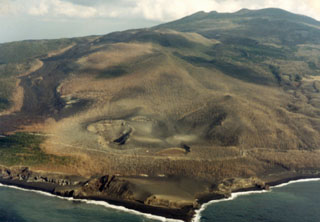Report on Miyakejima (Japan) — 8 April-14 April 2009
Smithsonian Institution / US Geological Survey
Weekly Volcanic Activity Report, 8 April-14 April 2009
Managing Editor: Sally Sennert.
Please cite this report as:
Global Volcanism Program, 2009. Report on Miyakejima (Japan) (Sennert, S, ed.). Weekly Volcanic Activity Report, 8 April-14 April 2009. Smithsonian Institution and US Geological Survey.
Miyakejima
Japan
34.094°N, 139.526°E; summit elev. 775 m
All times are local (unless otherwise noted)
JMA reported that on 1 April an eruption from Miyake-jima produced an ash plume that rose 600 m above the crater and drifted E. They also stated that the last eruption was on 8 May 2008.
Geological Summary. The circular, 8-km-wide island of Miyakejima forms a low-angle stratovolcano that rises about 1,100 m from the sea floor in the northern Izu Islands about 200 km SSW of Tokyo. The basaltic volcano is truncated by small summit calderas, one of which, 3.5 km wide, was formed during a major eruption about 2,500 years ago. Numerous craters and vents, including maars near the coast and radially oriented fissure vents, are present on the flanks. Frequent eruptions have been recorded since 1085 CE at vents ranging from the summit to below sea level, causing much damage on this small populated island. After a three-century-long hiatus ending in 1469 CE, activity has been dominated by flank fissure eruptions sometimes accompanied by minor summit eruptions. A 1.6-km-wide summit crater was slowly formed by subsidence during an eruption in 2000.

